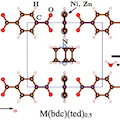Abstract
Metal organic framework (MOF) materials have attracted a lot of attention due to their numerous applications in fields such as hydrogen storage, carbon capture and gas sequestration. In all these applications, van der Waals forces dominate the interaction between the small guest molecules and the walls of the MOFs. In this review article, we describe how a combined theoretical and experimental approach can successfully be used to study those weak interactions and elucidate the adsorption mechanisms important for various applications. On the theory side, we show that, while standard density functional theory is not capable of correctly describing van der Waals interactions, functionals especially designed to include van der Waals forces exist, yielding results in remarkable agreement with experiment. From the experimental point of view, we show examples in which IR adsorption and Raman spectroscopy are essential to study molecule/MOF interactions. Importantly, we emphasize throughout this review that a combination of theory and experiment is crucial to effectively gain further understanding. In particular, we review such combined studies for the adsorption mechanism of small molecules in MOFs, the chemical stability of MOFs under humid conditions, water cluster formation inside MOFs, and the diffusion of small molecules into MOFs. The understanding of these phenomena is critical for the rational design of new MOFs with desired properties.
